Statistical Analysis of Vertical and Torsional Whipping Response Based on Full-Scale Measurement of a Large Container Ship
Abstract
:1. Introduction
2. Full-Scale Measurement
2.1. Sensor Arrangement and Data Obtained Onboard
2.2. Weather Data
3. Data Analysis Methodology
3.1. Method of Analysis of the Whipping Factor
- Time-series stress data measured at the four corners of the midship are prepared. An example of the time-series data is shown at the top of Figure 2.
- The time-series data is decomposed into four components: vertical bending, horizontal bending, torsion, and axial force. An example of the decomposed time-series data is shown in Figure 3.
- From the four time-series stress data obtained, a low-frequency component, less than 0.01 Hz, and a high-frequency component, greater than 2.0 Hz, are removed by a band-path filter to remove the mean value drift and noise. The obtained time-series stress data, including the frequency range of 0.01–2.0 Hz, are used as the raw data. Then, a low-pass filter is applied to the raw data with a cutoff frequency of 0.3 Hz to obtain the wave response component. An example time series of the raw data and the extracted wave component are included in Figure 4 to show how the low-frequency component is decomposed from the raw data.
- For the obtained wave response component, the zero up-crossing period is determined using the zero up-cross method, and the peak value, σw,i, in hogging is determined for each period i. The peak value of the raw data, σr,i, is also determined for the same period obtained from the zero up-crossing of the wave response component. This procedure is illustrated in Figure 4.
- These single-amplitude extrema, both for the wave response component and for the raw data, are statistically represented in the frequency distribution, and are approximated by the Weibull distribution. Weibull fitting is performed using the least squares method on the data of the top 20% of the single-amplitude extrema. Each curve shown in Figure 5 was obtained using the Weibull approximation.
- Then, 1/1000 maximum expected values are calculated for both the wave response component and the raw data, as shown in Figure 5. Finally, as depicted, the whipping factor is calculated by taking the ratio of the 1/1000 maximum expected value of the raw data to the 1/1000 maximum expected value of the wave response component.
3.2. Decomposition of Stress into Four Components
4. Results of Whipping Factor Analyses for Each Stress Component
5. Analyses and Discussion of the Whipping Factor
5.1. Comparison Results of the Vertical Bending, Torsional, and Horizontal Bending Components
5.2. Discussion on the Vertical Longitudinal Bending Component
6. Conclusions
- It was found that the whipping factors in the torsional and horizontal bending components were much smaller than the whipping factors in the vertical longitudinal bending component. In addition, the magnitude of the torsional component was approximately one-third of the vertical bending component, and the magnitude of the horizontal bending stress was approximately one-fifth of the vertical bending stress in terms of raw data extreme values. Thus, it is considered that the torsional and horizontal bending stresses have considerably less influence on the whipping than the vertical longitudinal bending stress.
- We studied the correlation between the whipping factors of the vertical bending component and the corresponding sea state and ship operational conditions. As a result, it was found that the whipping factor slightly decreased as the wave period increased. In addition, the whipping factor tends to be larger in head seas, and larger ship speeds result in greater whipping factors in head seas. In contrast, a larger ship speed does not affect or even slightly reduces the whipping factor in following seas.
- Excessively large whipping is sometimes observed due to successive wave impact that accidentally accelerates the existing whipping vibration of the hull girder. Conversely, when whipping works to cancel the vibrational component, the vibrational component may suddenly decrease.
Author Contributions
Funding
Acknowledgments
Conflicts of Interest
References
- Okada, T.; Takeda, Y.; Maeda, T. On board measurement of stresses and deflections of a post-panamax containership and its feedback to rational design. Mar. Struct. 2006, 19, 141–172. [Google Scholar] [CrossRef]
- Sumi, Y.; Fujikubo, M.; Fujita, H.; Kawagoe, Y.; Kidogawa, M.; Kobayashi, K.; Nakano, T.; Iwano, J.; Takahira, T.; Tamura, K. Final Report of Committee on Large Container Ship Safety; Committee on Large Container Ship Safety: Japan, 2015. [Google Scholar]
- ClassNK. Investigation Report on Structural Safety of Large Container Ships; The Investigation Panel on Large Container Ship Safety: Japan, 2014. [Google Scholar]
- Ki, H.G.; Park, S.G.; Jang, I.H. Full scale measurement of 14k TEU containership. In Proceedings of the 7th International Conference on Hydro elasticity in Marine Technology, Split, Croatia, 16–19 September 2015; pp. 311–328. [Google Scholar]
- Kim, Y.; Kim, B.H.; Choi, B.K.; Park, S.G.; Malenica, S. Analysis on the full-scale measurement data of 9400TEU container carrier with hydroelastic response. Mar. Struct. 2018, 61, 25–45. [Google Scholar] [CrossRef]
- Kim, Y.; Kim, B.H.; Park, S.G.; Choi, B.K.; Malenica, S. On the torsional vibratory response of 13000 TEU container carrier – full scale measurement data analysis. Ocean Eng. 2018, 158, 15–28. [Google Scholar] [CrossRef]
- Storhaug, G.; Kahl, A. Full scale measurements of torsional vibrations on Post-Panamax container ships. In Proceedings of the 7th International Conference on Hydroelasticity in Marine Technology, Split, Croatia, 16–19 September 2015. [Google Scholar]
- Miyashita, T.; Okada, T.; Seki, N.; Kawamura, Y. A comparative study of whipping response of a large container ship based on numerical analysis and full-scale measurements. In Proceedings of the 32nd Asian-Pacific Technical Exchange and Advisory Meeting on Marine Structures (TEAM 2018), Wuhan, China, 15–18 October 2018; pp. 510–517. [Google Scholar]
- Miyashita, T.; Okada, T.; Seki, N.; Kawamura, Y.; Hanada, R. Statistical characteristics of whipping response of a large container ship under various sea states and navigational conditions based on full-scale measurements. In Proceedings of the 14th International Symposium on Practical Design of Ships and Other Floating Structures (PRADS 2019), Yokohama, Japan, 22–26 September 2019. [Google Scholar]
- Kawabe, H.; Shigemi, H.; Matsumoto, T.; Ishibashi, K.; Toyoda, K. Quantitative estimation method for vertical wave-induced bending moments of very large container ships in consideration of the effects of whipping. J. Jpn. Soc. Nav. Archit. Ocean Eng. 2016, 22, 477–482. [Google Scholar]
- Nitta, A.; Yuasa, M. Measurements and long-term predictions on the longitudinal strength of container ship. J. Soc. Nav. Archit. Jpn. 1977, 141, 160–166. [Google Scholar] [CrossRef]
- Niki, R.; Chen, X.; Okada, T.; Kawamura, Y.; Higashimoto, M. Whipping response evaluation based on monitoring data of 14,000TEU large container ships. J. Jpn. Soc. Nav. Archit. Ocean Eng. 2018, 26, 275–280. [Google Scholar]

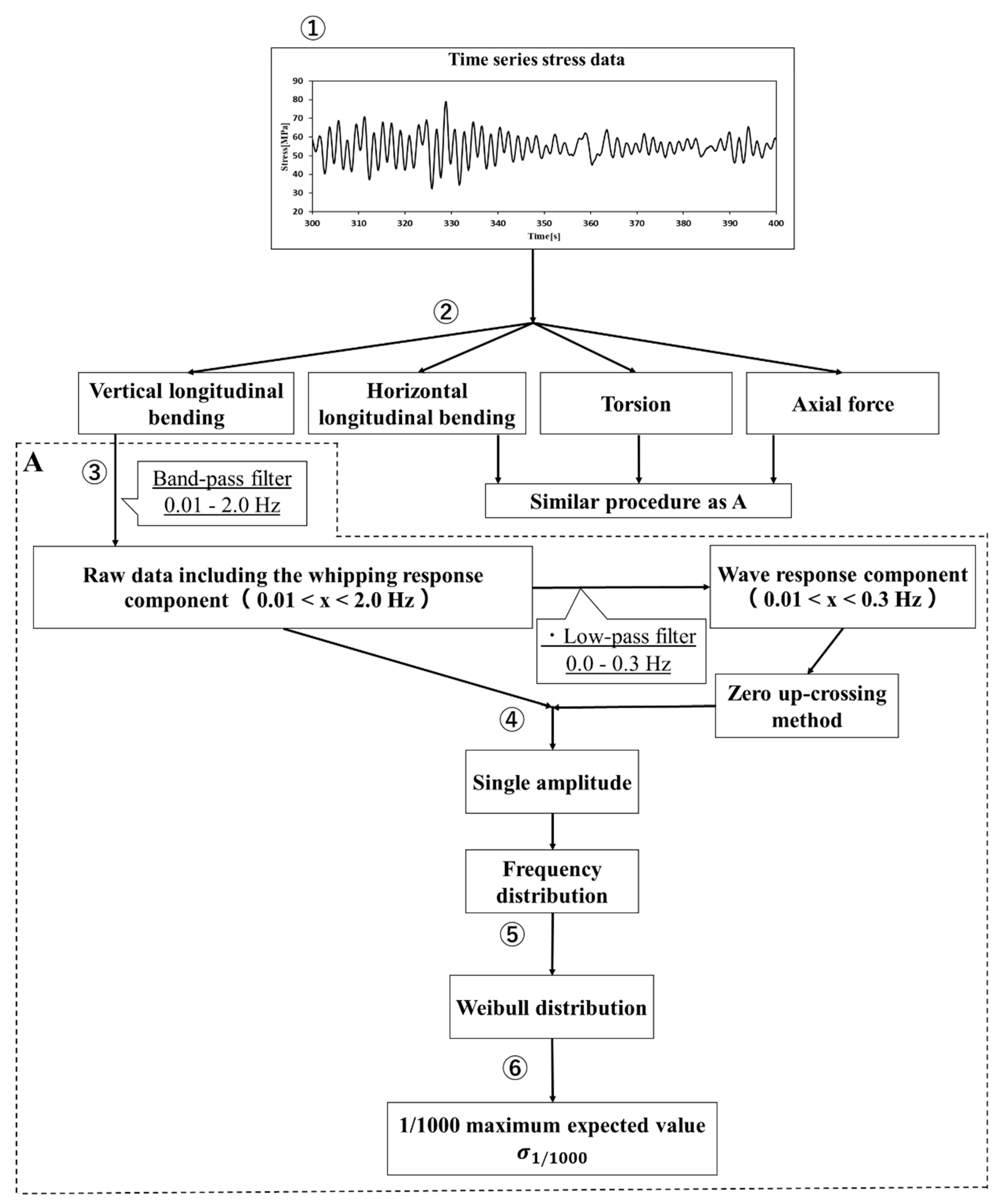
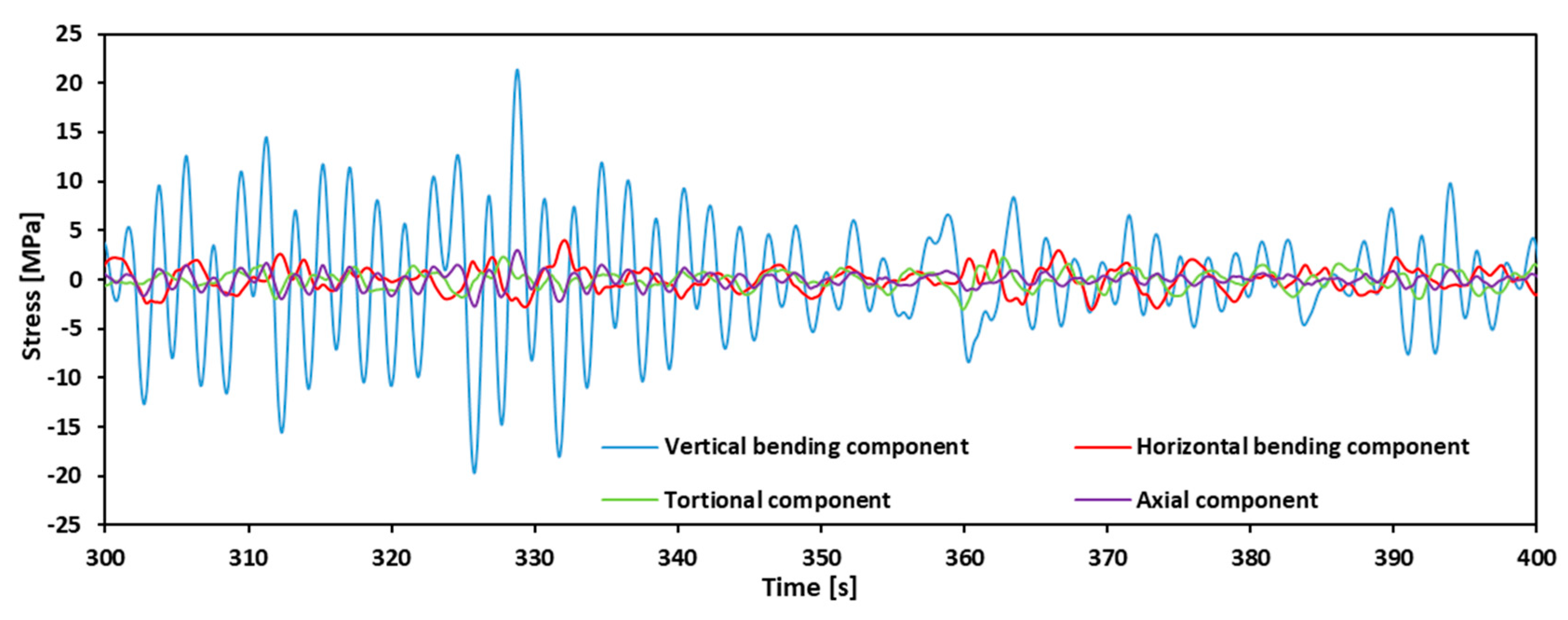
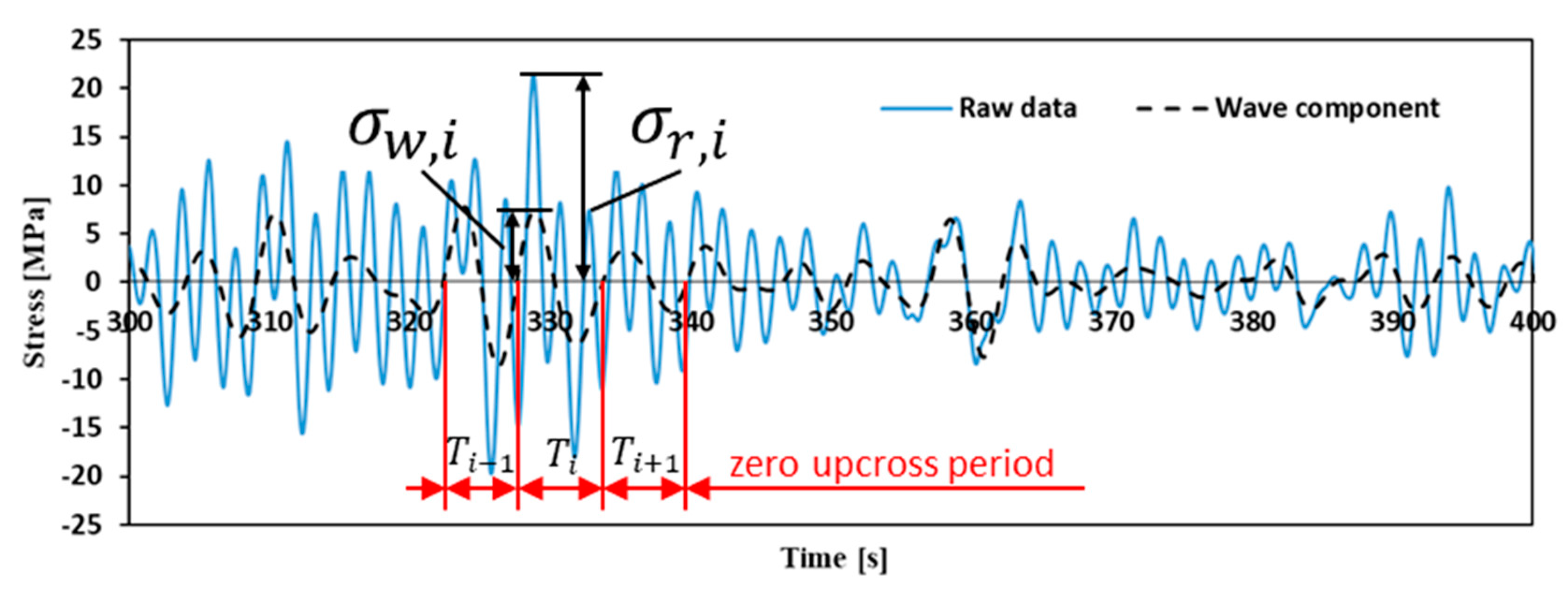

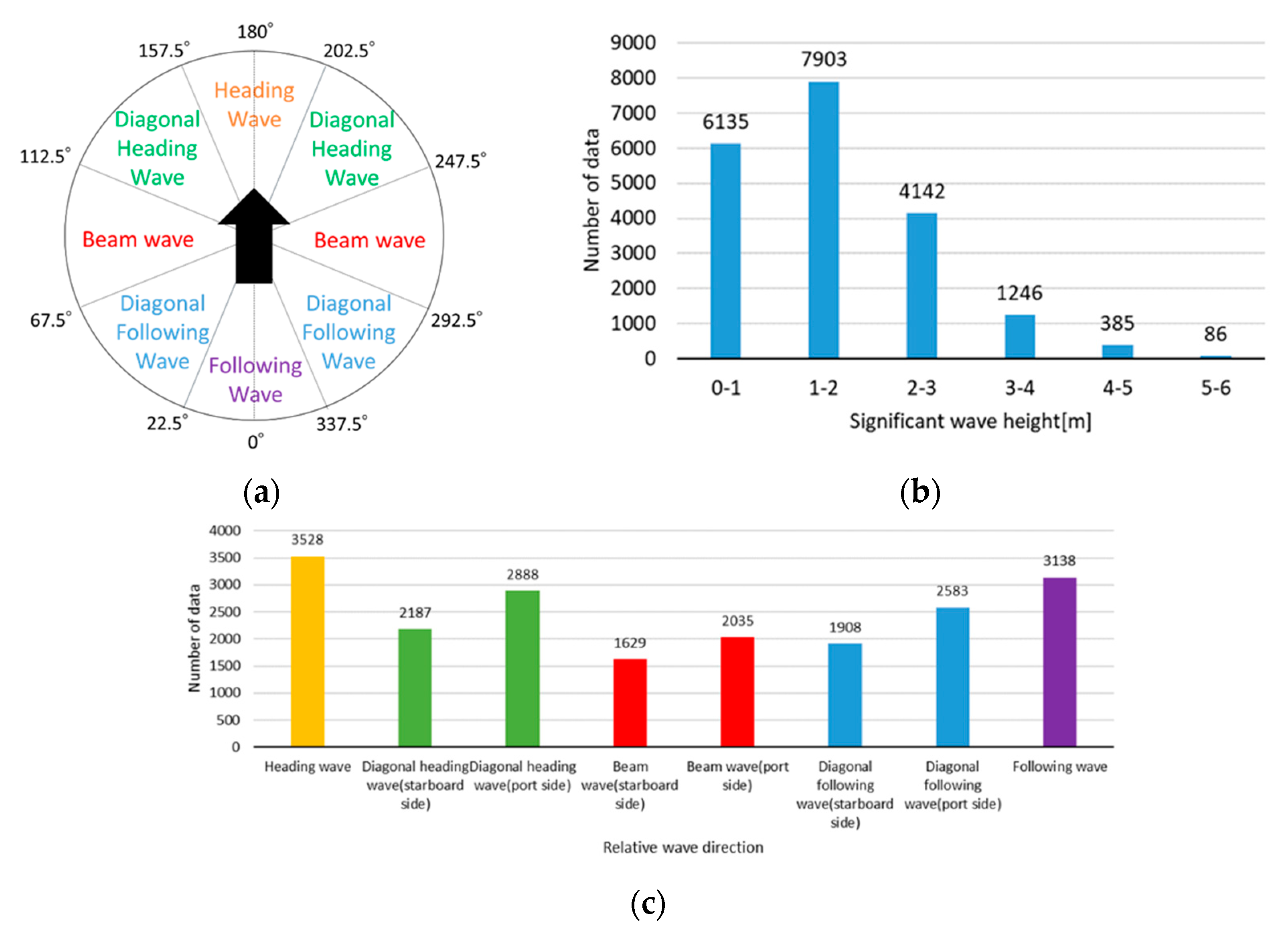
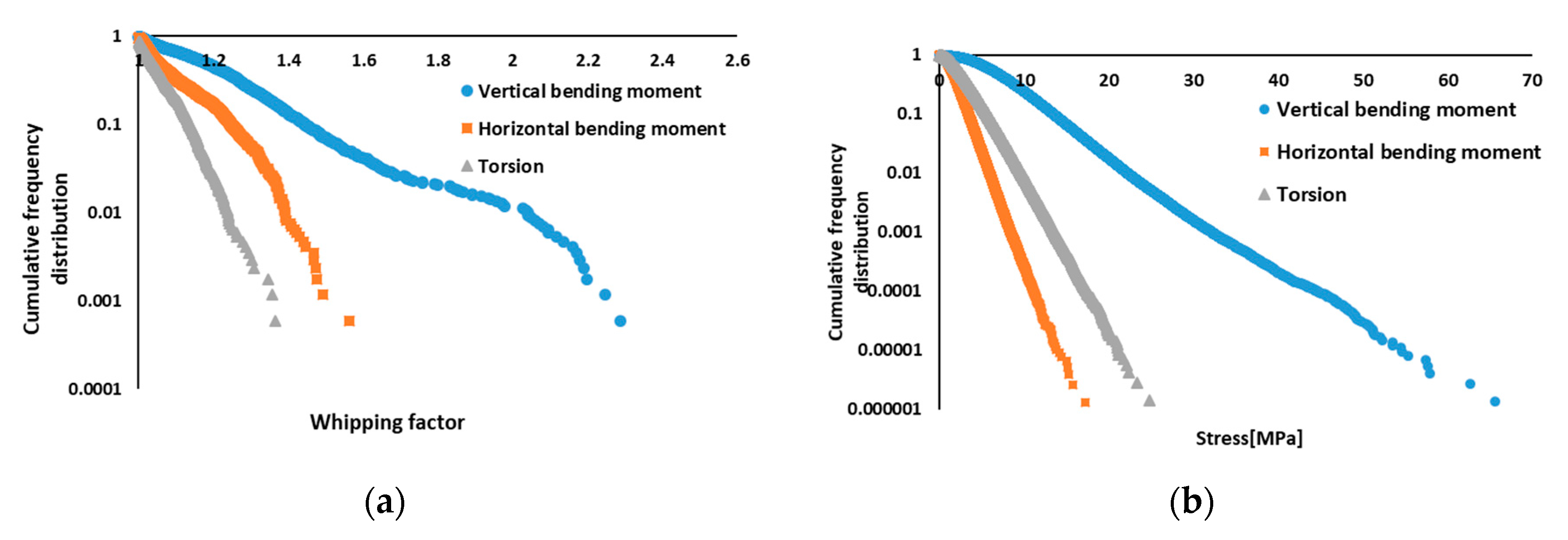


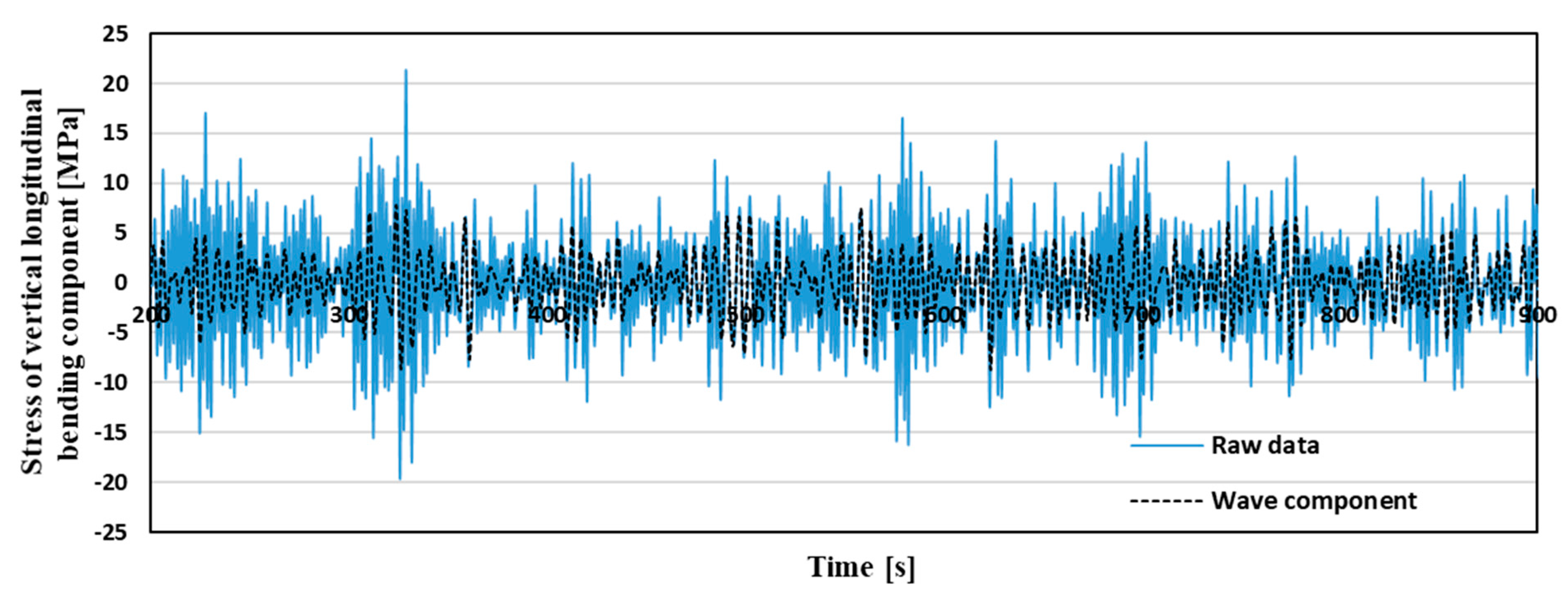


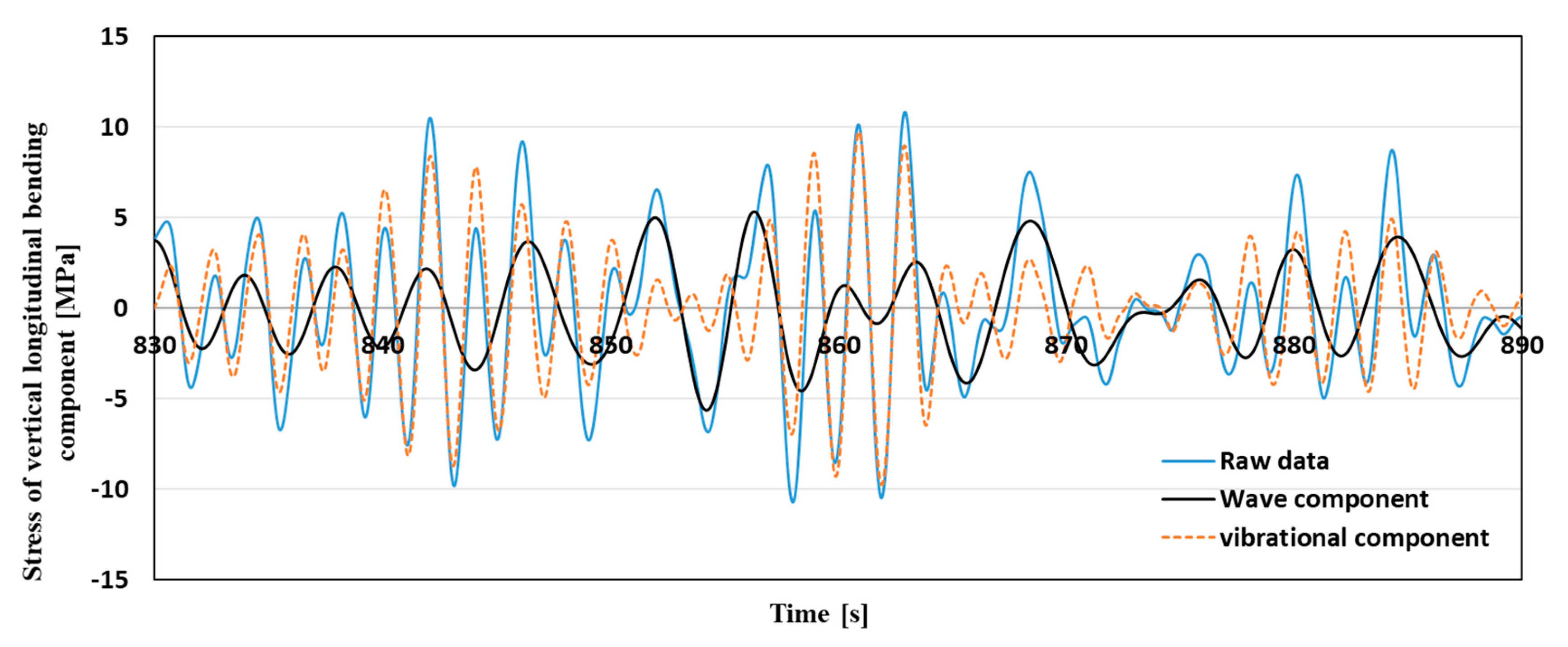
| LOA | 334.5 m |
| Breadth | 45.6 m |
| Depth | 24.4 m |
| Design Draft | 14.0 m |
| Gross Tonnage | 97,000 ton |
| Max. service speed | 24.5 knot |
| DFP/DFS | Deck at fore port/starboard |
| BFP/BFS | Lower longitudinal bulkhead at fore port/starboard |
| DMP/DMS | Deck at midship port/starboard |
| BMP/BMS | Lower longitudinal bulkhead at midship port/starboard |
| DAP/DAS | Deck at aft port/starboard |
| BAP/BAS | Lower longitudinal bulkhead at aft port/starboard |
| (a) | ||||||
| Average Wave Period [s] | ||||||
| 2.0–4.0 | 4.0–6.0 | 6.0–8.0 | 8.0–10.0 | 10.0– | ||
| Significant Wave Height [m] | 0.0–1.0 | 3.358(214) | 4.171(612) | 2.303(325) | 1.321(139) | 1.222(70) |
| 1.0–2.0 | – | 3.146(194) | 2.067(551) | 1.347(247) | 1.182(183) | |
| 2.0–3.0 | – | – | 1.634(339) | 1.242(245) | 1.224(73) | |
| 3.0–4.0 | – | – | 1.429(45) | 1.314(193) | 1.255(30) | |
| 4.0–5.0 | – | – | 1.455(1) | 1.380(24) | 1.232(8) | |
| 5.0–6.0 | – | – | – | – | 1.235(11) | |
| 6.0– | – | – | – | – | – | |
| (b) | ||||||
| Average Wave Period [s] | ||||||
| 2.0–4.0 | 4.0–6.0 | 6.0–8.0 | 8.0–10.0 | 10.0– | ||
| Significant Wave Height [m] | 0.0–1.0 | 2.191(214) | 2.113(612) | 1.458(325) | 1.221(139) | 1.245(70) |
| 1.0–2.0 | – | 1.558(194) | 1.211(551) | 1.085(247) | 1.061(183) | |
| 2.0–3.0 | – | – | 1.080(339) | 1.048(245) | 1.061(73) | |
| 3.0–4.0 | – | – | 1.090(45) | 1.070(193) | 1.079(30) | |
| 4.0–5.0 | – | – | 1.063(1) | 1.094(24) | 1.085(8) | |
| 5.0–6.0 | – | – | – | – | 1.052(11) | |
| 6.0– | – | – | – | – | – | |
| (c) | ||||||
| Average Wave Period [s] | ||||||
| 2.0–4.0 | 4.0–6.0 | 6.0–8.0 | 8.0–10.0 | 10.0– | ||
| Significant Wave Height [m] | 0.0–1.0 | 2.066(214) | 2.167(612) | 1.506(325) | 1.233(139) | 1.261(70) |
| 1.0–2.0 | – | 1.660(194) | 1.270(551) | 1.117(247) | 1.082(183) | |
| 2.0–3.0 | – | – | 1.151(339) | 1.077(245) | 1.099(73) | |
| 3.0–4.0 | – | – | 1.146(45) | 1.142(193) | 1.104(30) | |
| 4.0–5.0 | – | – | 1.390(1) | 1.214(24) | 1.158(8) | |
| 5.0–6.0 | – | – | – | – | 1.184(11) | |
| 6.0– | – | – | – | – | – | |
| (a) | ||||||
| Average Wave Period [s] | ||||||
| 2.0–4.0 | 4.0–6.0 | 6.0–8.0 | 8.0–10.0 | 10.0– | ||
| Significant Wave Height [m] | 0.0–1.0 | 3.45(162) | 3.32(563) | 1.91(315) | 1.25(137) | 1.26(106) |
| 1.0–2.0 | – | 2.67(221) | 1.68(793) | 1.23(677) | 1.19(435) | |
| 2.0–3.0 | – | – | 1.42(328) | 1.29(367) | 1.18(303) | |
| 3.0–4.0 | – | – | 1.53(67) | 1.32(143) | 1.20(207) | |
| 4.0–5.0 | – | – | 1.07(1) | 1.22(70) | 1.23(87) | |
| 5.0–6.0 | – | – | – | 1.02(6) | 1.34(16) | |
| 6.0– | – | – | – | – | – | |
| (b) | ||||||
| Average Wave Period [s] | ||||||
| 2.0–4.0 | 4.0–6.0 | 6.0–8.0 | 8.0–10.0 | 10.0– | ||
| Significant Wave Height [m] | 0.0–1.0 | 2.14(162) | 1.75(563) | 1.29(315) | 1.13(137) | 1.12(106) |
| 1.0–2.0 | – | 1.38(221) | 1.11(793) | 1.05(677) | 1.05(435) | |
| 2.0–3.0 | – | – | 1.06(328) | 1.04(367) | 1.03(303) | |
| 3.0–4.0 | – | – | 1.09(67) | 1.07(143) | 1.07(207) | |
| 4.0–5.0 | – | – | 0.98(1) | 1.09(70) | 1.07(87) | |
| 5.0–6.0 | – | – | – | 1.00(6) | 1.11(16) | |
| 6.0– | – | – | – | – | – | |
| (c) | ||||||
| Average Wave Period [s] | ||||||
| 2.0–4.0 | 4.0–6.0 | 6.0–8.0 | 8.0–10.0 | 10.0– | ||
| Significant Wave Height [m] | 0.0–1.0 | 2.608(162) | 1.718(563) | 1.321(315) | 1.137(137) | 1.110(106) |
| 1.0–2.0 | – | 1.430(221) | 1.139(793) | 1.071(677) | 1.065(435) | |
| 2.0–3.0 | – | – | 1.119(328) | 1.078(367) | 1.049(303) | |
| 3.0–4.0 | – | – | 1.169(67) | 1.148(143) | 1.087(207) | |
| 4.0–5.0 | – | – | 1.011(1) | 1.121(70) | 1.099(87) | |
| 5.0–6.0 | – | – | – | 1.019(6) | 1.085(16) | |
| 6.0– | – | – | – | – | – | |
| Date | Whipping Factor | Significant Wave Height [m] | Average Wave Period [s] | Relative Wave Direction [°] | Ship Speed [knot] |
|---|---|---|---|---|---|
| 2012/5/22 11:00-11:59 | 2.199 | 3.1 | 8.4 | 188.1 | 19 |
© 2020 by the authors. Licensee MDPI, Basel, Switzerland. This article is an open access article distributed under the terms and conditions of the Creative Commons Attribution (CC BY) license (http://creativecommons.org/licenses/by/4.0/).
Share and Cite
Hanada, R.; Okada, T.; Kawamura, Y.; Miyashita, T. Statistical Analysis of Vertical and Torsional Whipping Response Based on Full-Scale Measurement of a Large Container Ship. Appl. Sci. 2020, 10, 2978. https://doi.org/10.3390/app10082978
Hanada R, Okada T, Kawamura Y, Miyashita T. Statistical Analysis of Vertical and Torsional Whipping Response Based on Full-Scale Measurement of a Large Container Ship. Applied Sciences. 2020; 10(8):2978. https://doi.org/10.3390/app10082978
Chicago/Turabian StyleHanada, Ryo, Tetsuo Okada, Yasumi Kawamura, and Tetsuji Miyashita. 2020. "Statistical Analysis of Vertical and Torsional Whipping Response Based on Full-Scale Measurement of a Large Container Ship" Applied Sciences 10, no. 8: 2978. https://doi.org/10.3390/app10082978





